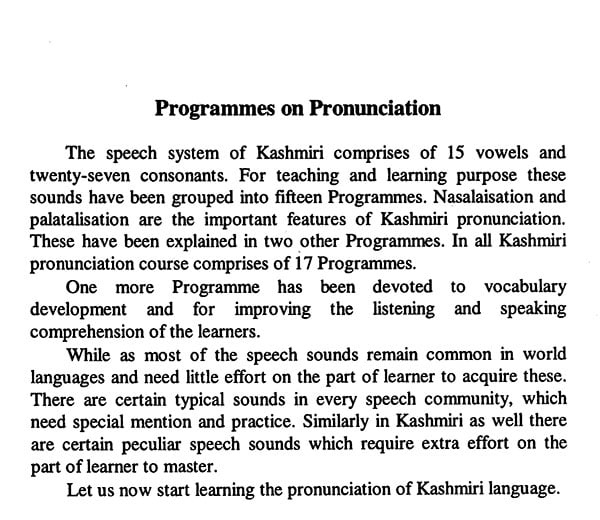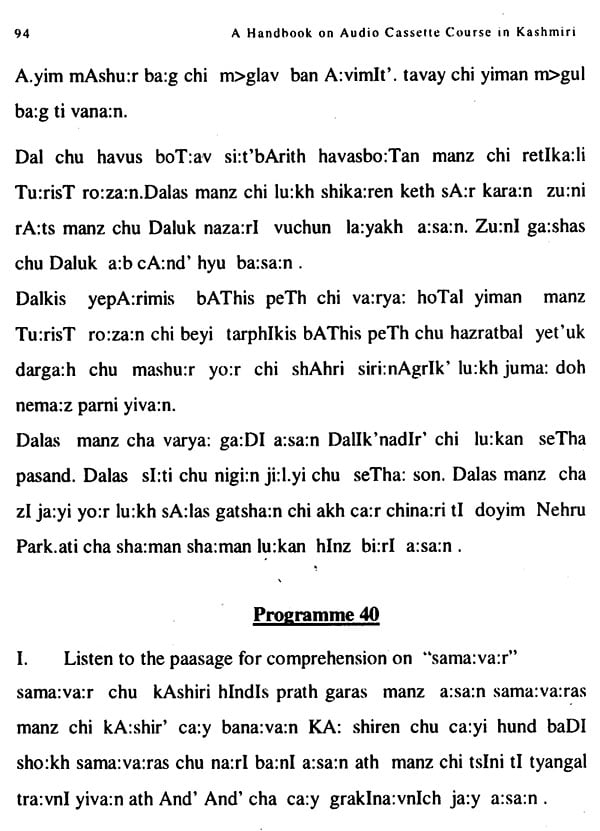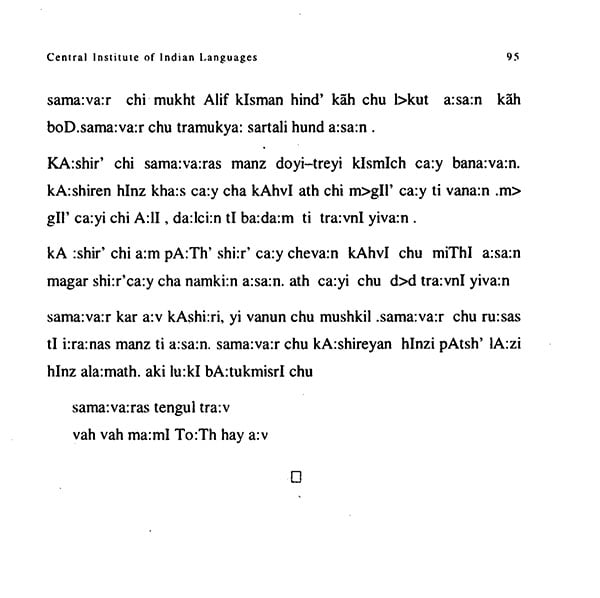
A Handbook on Audio Cassette Course in Kashmiri
Book Specification
| Item Code: | NAX309 |
| Author: | Roop Krishen Bhat |
| Publisher: | Central Institute Of Indian Languages, Mysore |
| Language: | Kashmiri Text With English Transaltion |
| Edition: | 2002 |
| ISBN: | 8173420904 |
| Pages: | 95 |
| Cover: | HARDCOVER |
| Other Details | 9.00 X 7.00 inch |
| Weight | 240 gm |
Book Description
The recent unfortunate displacement and migration of the population from Kashmir to various parts of the country has made Kashmir a "wounded civilization". The traditional knowledge of Kashmir is slowly and gradually disappearing and the identity of the community is in peril. The worst fear is that the new generation which was born after the migration and is being raised outside Kashmir may not have access to this traditional knowledge. In order to save and make this knowledge available to this new generation, it was felt that a course on Kashmiri may help to a great extent in fulfilling this need. The Cassette Course on Kashmiri language, produced and introduced by Roop Krishen Bhat, Principal of our Northern Centre at Patiala, is a step in the direction of promoting and propagating teaching/learning of this immensely rich language. The cassettes would be invaluable tools for those who wish to use them as self-instructional materials placing it along-side our regular course materials on Kashmiri.
The areas such as Language Teaching always attracted the faculty at the Central Institute of Indian Languages, and as a result, a lot of interesting materials got produced. The present Cassette Course in Kashmiri has been produced in the same series. Our teaching materials have so far been tried out through a series of 10 months Intertsive Training Programme currently offered in the seven regional centres of the Institute at three levels: Basic, Intermediate and Advanced courses. The present set is, however, suitable to be used not only for such language learners who are to be taught as a part of our programme, but also by those who have had introduction to the language through a formal system, and yet have not had chance to go beyond the basics. They cover a wide range of speech styles used in the language so that both teachers and auto-learners of Kashmiri as a L2 could benefit.
The text used here are not merely instances of ideal spoken styles, they are also used to emphasize on certain recurring grammatical patterns and lexical coinages.
I congratulate the teachers who have used and perfected the material as much as the author, Roop Krishen Bhat. The suggestions, comments, criticisms from all those who may use this teaching material will be most welcome.
Kashmir, better known as the heaven on earth, is the most prominent part of the Indian State of Jammu and Kashmir. Praised equally by the sages, kings, chroniclers, writers and poets, Kashmir has a very rich folk and cultural history. It remained the highest seat of learning for the scholars of India and abroad during the ancient times.
The great Indian religious schools like Kashmir Shaivism logic, Buddhism and later Islam acquired their new dimensions in the heavenly environment of the valley. A Persian poet praising the climatic conditions of the valley had gone to the extent of saying that if a roasted chicken was brought to Kashmir, it would certainly grow the feathers afresh. This being the abode of Sharda (Saraswati) or the Goddess of wisdom, Kashmir valley had the pride of originating was rightfully proud of having been the place of origin of various schools of thought.
The people of Kashmir, called KA-:shir’ locally, and Kashmiris generally, are real down to earth, simple and God - fearing people. Warm at heart, emotional and loving, they have been recognized for their intelligence and also as the best hosts. The people of Kashmir speak Kashmiri as their mother tongue, a language of the Indo-Aryan stock. Locally known as KAshur, the language has three regional and some social dialects. The number of Kashmiri speaker’s is 30,76,398, as per the census figures of 1981. This excludes the number of the speakers in the Pakistan Occupied Kashmir (POK) across the line of control (LOC). Kashmiri language is spoken in the valley of Kashmir invariably and in some parts of Jammu and Ladhak regions of the state bordering the valley.
The ancient script in use for Kashmiri was Sharda a development from the Brahmi. But now its use remains restricted to religious Scriptures and writing horoscopes. Kashmiri language is written in both Persio-Arabic and Devanagri scripts. However, the Persio-Arabic script is the recognized script even used in for the currency notes. Kashmiri is included in the eighth schedule of constitution of recognized regional languages of India. But unfortunately it hasn’t so far earned the status of the official language or even the second official language in the state of Jammu and Kashmir. As such, its use is restricted to common speech and literary activities.
Kashmiri has certain linguistic peculiarities. At the phonetic and phonological level it has certain vowels and consonants hardly found in any other Indian language. At the vowel level the cent vowels [I and A with their counterparts long [I: and A: also thral vowel [o has certain distinctive features, which distinguish it from other similar sounds that are found in other Indian languages. At the consonant level, the dental fricative [ts] and its aspirated form [tsh] are rarely found in other Indian languages except in Marathi. At the structural level, unlike in other Indian languages, Kashmiri has a basic SVO (Subject Verb Object) word order. The pronominalization is yet another specific feature of Kashmiri. In this process the main verbs get inflected for the pronouns.
The learning material for Kashmiri is scarcely available. However, the Central Institute of Indian languages (CIIL) and its northern wing, viz. Northern Regional Language Center, Patiala, have been producing the learning and teaching material. But a need was felt to produce the present set of materials for the self-learning course.










